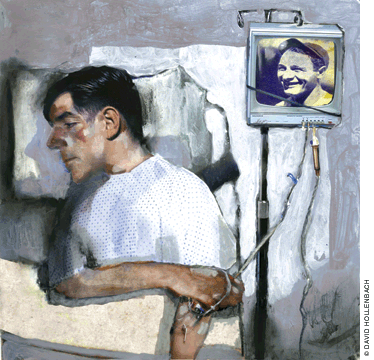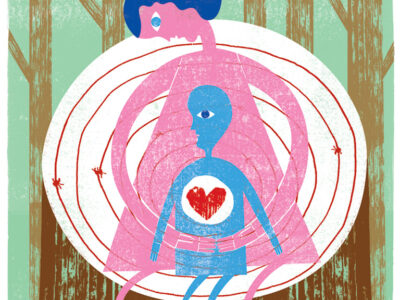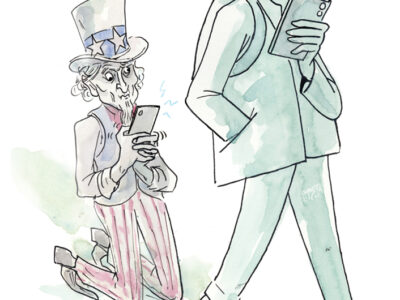
What stories about celebrities and their illnesses mean to the rest of us.
By Barron H. Lerner | After the baseball player Jimmy Piersall was discharged from a mental hospital in the 1950s, he informed the public how doctors had successfully treated his manic depression with psychotherapy and electro-shock treatment. In his 2000 book, It’s Not About the Bike, cycling champion Lance Armstrong wrote about how he chose to be treated for his testicular cancer at Indiana University instead of in his native Texas.
Perhaps the details of celebrity illnesses should not matter to Americans, but they do. Americans love to emulate celebrities, and sick celebrities are no exception.
This phenomenon, however, flies in the face of another trend that has become increasingly important: evidence-based medicine, in which patients and doctors are encouraged to base clinical decisions on the best data collected among populations—not on the cases of individual patients.
How did the reverence for celebrity patients develop and should we be concerned that it sends the wrong message?
The first modern celebrity patient was Lou Gehrig. After the Mayo Clinic diagnosed the durable New York Yankees first baseman with amyotrophic lateral sclerosis (ALS) in 1939, it issued a press release that was broadcast by media across the country. As a result, Gehrig received letters from thousands of people, some just wishing him luck but others seeking information about his illness and the treatments he was receiving.
Those treatments turned out to be a series of vitamin injections, which doctors hoped would cure his progressive neurological disease. Gehrig even entered a clinical trial of Vitamin E injections that in 1940 were reported to have actually improved his condition.
Unfortunately, they had not. Gehrig was dead by the next year. But the sense that the ballplayer had nobly fought his disease, and at one point might have been beating it, would stay with the public for years. Pride of the Yankees, the World War II-era Hollywood tearjerker starring Gary Cooper, opened with the quote that Gehrig had “faced death with that same valor and fortitude that has been displayed by thousands of Americans on far-flung fields of battle.”
In fact, Gehrig had simply done what most ALS patients did: try whatever was available to treat their disease and, at the end, acquiesce to the inevitability of an unfair death.
This image of celebrity patient as role model recurred with the now-forgotten illness of Margaret Bourke-White, probably the most accomplished woman photographer of the mid-20th century. After experiencing stiffness of her arms and legs in the mid-1950s, Bourke-White was eventually diagnosed with Parkinson’s disease, an especially ironic condition for someone who depended on lightning-fast reflexes.
In 1959 Bourke-White chose to undergo an experimental operation in which a portion of her brain—the thalamus—was purposely damaged to alleviate the stiffness in her limbs. Given her initial enthusiasm about how well the procedure had worked, Bourke-White and her photography colleague Alfred Eisenstaedt published a photo essay in Life magazine entitled “Famous Lady’s Indomitable Fight.”
Bourke-White received even more correspondence than Gehrig, much of which inquired about the operation and her recovery. The photographer’s positive report surely urged hundreds, perhaps thousands, of other Parkinson’s patients to have the operation or a variant. But as important to the public as the medical value of the surgery was Bourke-White’s role as an inspiration for other discouraged patients. “The doctors here say there is no cure,” wrote one man with Parkinson’s, “but your story made me believe there is some help and hope.”
Until her death in 1971, Bourke-White struggled with the question of whether her operation had actually helped her, even seeking out other people who had undergone the same surgery. Her difficulty in answering this question well demonstrates the problem of assessing medical treatments based on one or a few cases.
In fact, like using Vitamin E for ALS, damaging the thalamus never was shown to be effective for treating Parkinson’s. Both Gehrig and Bourke-White were thus celebrities whose cases potentially misled the public. So was Steve McQueen, who traveled to Mexico in 1980 to receive a highly unorthodox treatment for his end-stage mesothelioma, a cancer of the lining of the lungs: over 50 daily vitamins and minerals, an anticancer compound made from apricot pits known as Laetrile, and even coffee enemas. McQueen died anyway but thousands of desperate cancer patients followed him to Mexico.
In some cases, however, celebrities appeared to have made the right choices. Piersall, for example, was back in uniform in 1953 and played 16 years in the majors. His book and the subsequent movie based on it, Fear Strikes Out, destigmatized mental illness and provided candid information about sick people who were too often shunned and institutionalized.
And Lance Armstrong seems to have made just the right decision. Not only did he avoid using a chemotherapeutic drug that would have damaged his lungs and ended his cycling career, but he recently celebrated the 10th anniversary of his diagnosis. Moreover, Armstrong has used his story not to promote a specific drug regimen but to educate the public more broadly about testicular and other cancers.
Regardless of whether the celebrities recovered or not, these illness stories are the exact ones that worry experts in medical decision-making. The field of evidence-based medicine, which has come to prominence over the past few decades, argues that sophisticated scientific studies of treatments—specifically, randomized controlled trials and more elaborate meta-analyses—provide the best information. Because these studies avoid biases that result from looking at unrepresentative cases, patients and doctors will not be misled.
This argument makes a great deal of sense. The best data should surely be used to guide clinical decisions, insurance coverage, and allocation of research funding.
But the history of celebrity patients should remind us that sick people do not simply want to examine the scientific literature. Rather, at a time of illness, stories are important, whether those of true celebrities, like Gehrig and Armstrong, or “local” celebrities, like one’s relative or friend who had a particular disease.
Rather than dismissing such cases as worthless anecdotes, we should acknowledge that what sick people want are not only good statistics but also stories—stories of hope, innovation, and inspiration.
Barron H. Lerner C’82 is the Angelica Berrie-Gold Foundation Associate Professor at Columbia University and the author of When Illness Goes Public: Celebrity Patients and How We Look at Medicine (Johns Hopkins, 2006). He will be giving a presentation on celebrity patients at Alumni Weekend this month.




